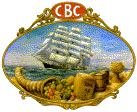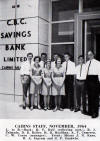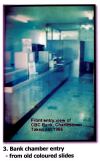
  
| | 
Cairns
14 Shields Street | 
1964
>1979

2008 | 1975 Listed in Annual Report
1964 November This photo is reproduced from Current Accounts, January, 1965.
Frank Maundrell says: It is more a photo of the Branch staff than of the premises. Nevertheless, they are all identified and it is interesting to note the then tie fashion, as worn by all the men. We used to call them "Slim Jims"!
As featured in Geoffrey Banham's book
"Cairns branch of the C.B.C. bank was at 14 Shield Street in the city centre. It was a two story building with the main banking chamber, tellers (4 or 5), accountant, assistant accountant, some other staff and the new Assistant Managers office on the ground floor. Upstairs housed the Manager, lending support staff and Managers' typist/receptionist, plus lunch room, toilets etc. Combined staff numbers were about 18. The lending portfolio had been split and each manager had their own customer base. We each had our own support staff. Its size was far removed from AMP Place branch in Brisbane. I no longer had the responsibility for many of my former duties. Many of them were shared by the Accountant and Assistant Accoungtant."2008 July photo by Frank Maundrell is of the current NAB Branch at 14 Shields Street, Cairns, which is the old CBC site and is the same building depicted in Current Accounts November, 1964.I took the photo during my recent visit to Cairns in July this year and am pleased to report the old building is now the main representation for NAB in Cairns, housing the Business Banking Branch as well as the retail Branch. | | Caloundra |  | 1972 branch opened.
Picture from Current Accounts Jan 19731975 Listed in Annual Report | | Charlestown |   | c1966 photos as featured in Geoffrey Banham's book | Charleville
Cnr of Eyre & Alfred Sts
| 
1889
_small.jpg)
1890

2 - 1890

1905

1 - 1906

3

4

5

6

7 on left

10 old CBC site 2008

11
| Charleville is the largest town in South West Queensland and has a population of approximately 3300 people. It is a rich pastoral area and was first explored by Edmund Kennedy in 1847. Charleville was named by Surveyor W. Tully for his hometown in Ireland. Cobb and Co established their largest and longest running coach making factory in Charleville in 1886 and the railway line was connected from Brisbane in 1888. Charleville was one of the first airports used by Qantas to fly paying passengers to Longreach in 1922. It is also home to the Royal Flying Doctor Service and the Charleville School of the Air.
1884 This bank was opened on 23 July. It still stood in Wills Street at the time the State Library of Qld entered details.
Branch opened 23/7/1884 and was situated in Wills Street. The building has since been demolished and is now the site of Apex Park. Source: State Library of Queensland.
This is the branch in 1890/1905/1906 photos and photos 1 - 7 below.
1885 Opened (from Current Accounts January 1977).
1889 photo in Courier-Mail 24/7/2009 is image No. 168153 in Picture Queensland.
1890 similar photos of Charleville branch (b&w) from National Archives and Charleville Historic House (sepia close-up).
1893 January Listed in 89th Report;
1905 Group of gentlemen outside the Commercial Bank building in Wills Street, Charleville, ca. 1905 (Image No. 6681 SLQ), and
1906 (photo 1) Horsedrawn carriage and driver outside the Commercial Bank of Sydney, Charleville, ca. 1906 dated by State Library of Qld.
Photos from Charleville Historic House museum, arranged in apparent sequence by Frank Maundrell who visited Charleville in May 2008..
Photos 1 & 2 would be the oldest and are probably contemporary, taken in 1890 and 1906. I would expect that the chap in the fine turnout is the Manager of the day. It is interesting to note his briefcase and coat, which might indicate he was departing for a property inspection or visit. The tall chap in the middle of the group in photo 2 appears to be the same man.
Photos 2 and 3 probably depict staff of the day. They appear to all be appropriately dressed in a style befitting young Bank Officers. Even the extremes of summer heat in Charleville would not have been sufficient reason to dispense with high-buttoned shirts, starched collars and ties! Maybe they would be forgiven for removing coats.
Photos 3 to 7 all show additions not on the first two photos. The visible additions are an extension to the left-hand side of the building (as you look at it) and an entry porch, which appears flush to the wall in the first two pictures.
Photos 1, 3 and 4 depict a picket fence, whereas 5, 6 and 7 all show a wire fence, indicating a later era. It is interesting to note the hitching rail in photo 3, which is not as obvious in photo 4. The footpath tree in photo 4 is also more advanced.
1934 Listed in Century of Banking;
The CBC premises at Corner of Eyre and Alfred Streets (photos 1 to 7) were demolished at about the time the clearance sale took place. The site then became an “Apex” park. The Neighbourhood Centre was built on part of the site more recently. Small park amenities such as a BBQ, tables and chairs remain an integral part of the site.
Charleville Historic House provided all photos Numbered 1 to 8 inclusive. This organisation controls a museum housed in premises originally built for Queensland National Bank. That Bank vacated them and built new premises on a different location prior to its merger with NBA in 1948.
2008 May Frank Maundrell took photos 10 and 11. | Charleville
21 Wills Street | 
1975

8 1970s

9 2008 | 1975 Architect's impression of new branch which was occupied in June.
1975 Listed in Annual Report.
Notes from Frank Maundrell:
Photo 8 is of premises at 21 Wills Street. I have been unable to ascertain the date these premises were built. The design appears late-1960s or early-1970s. The chap in charge at Charleville Historic House, a life-long resident of Charleville, said he attended a clearance sale of the old CBC premises in the early 1970s, but he could not recall exactly which year. Perhaps the transport in front of the building is the Manager’s vehicle. This would be quite a contrast with that in photo 1!
1983 Following the CBC/NBA merger, NBA moved into the CBC premises, where it continues to operate as a full service NAB Branch.
2008 May Frank Maundrell took photo 9. | Childers
55 Churchill Street | 
1920

 |
Childers is 53Km South of Bundaberg.
1896 Opened (98th Report);
From National Trust of Queensland: The CBC Bank was established in Childers with the opening of a branch in rented premises in 1896.
1900 A permanent site was acquired in May 1989 and a purpose built banking chamber was completed by May 1900.
The building escaped the disastrous fire of 1902 which destroyed 18 commercial premises on the opposite (Southern) side of Churchill Street.
1908-9 additions to allow for accommodation above the banking chamber on the ground floor.
1911 listed in 125th Report;
1920 photo from Picture Australia of Childers Branch c1920 sourced by Geoff Chapman.
1934 Listed in Century of Banking
1943 January 25 branch closed as a wartime measure and business transferred to Bundaberg, 53km away.
1945 purchased by the Returned Soldiers Sailors & Airmens Imperial League of Australia for use as a club (RSL club).
Significance
The RSL Club building at Childers (formerly the Childers branch of the Commercial Banking Company of Sydney) demonstrates the growth and prosperity of the Isis as a sugar district in the early 20th century and the establishment of banking institutions to serve an expanding rural economy. It also demonstrates the growth of associations for returned service personnel in Australia following two major wars in which many Australians served and their wish to continue wartime comradeship. The former bank building demonstrates a common early practice in the design of provincial banks in which accommodation was provided on the premises for the manager and his family.
The RSLA Club is a dominant feature of Churchill Street and by its scale, form and detail makes an important contribution to the townscape of Childers.
As an RSLA club house since the end of World War Two to the present, the building has an important association with returned service personnel in the district.
The building is also associated with the life and work of J P O Cowlishaw as Queensland architect for the Commercial Banking Company of Sydney and with the operation of that banking institution in Queensland.
History
The RSLA Club was erected in 1900 as the Childers branch of the Commercial Banking Company of Sydney Limited. The bank was originally designed by architect James Percy Owen Cowlishaw as a single story building which in 1908 was raised to two storeys with the banking chamber located on the ground floor and manager's residence on the upper level.
Following logging of the dense Isis Scrub in the 1870s, Childers, in the heart of the scrub, was promoted in the 1880s by Maryborough interests, as an agricultural district. The land in the immediate vicinity of the present town of Childers was surveyed in 1882 into 50 acre farm blocks. There was no official town survey and Childers was developed following private subdivision at the railhead of the 1887 extension line from Isis Junction. This was opened on 31 October 1887, and was intended principally to facilitate the transport of timber from the scrub.
The coming of the railway not only promoted the development of the town of Childers; it also provided the catalyst for the establishment of a sugar industry in the district in the late 1880s. At the opening of the railway to Childers, Robert Cran, owner of Maryborough's Yengarie mill, announced that he would erect a double crushing juice mill at Doolbi, to supply his mill at Yengarie. This was completed in 1890, with the juice being brought in railway tankers from the Isis. Further expansion of the sugar industry in the Isis was closely related to the activities of the Colonial Sugar Refining Company, which erected a central crushing mill in the district 1893-94, and began crushing in 1895. By 1895, at least three other mills had been established in the Isis, with another two under construction, and Childers had emerged as the flourishing centre of a substantial sugar-growing district: in the years between 1891 and 1900 the population grew from 91 to 4000. In 1903 the old Isis Divisional Board (1886) was abolished and Isis Shire proclaimed, with the new seat of municipal government moving from Howard to Childers.
Whilst Queensland in general was slow to recover from the depression of the early 1890s and the 1893 banking crisis, the growth of commerce in Childers was attractive to banking institutions contemplating expansion. CBCS Bank opened its first branch in Childers, in rented premises, in 1897. Together with the Bank of North Queensland, who opened its branch in 1895, they were the first to capitalise on the need for banking facilities in the newly emerging sugar town. The Commercial Banking Company of Sydney was formed by New South Wales interests in 1834; establishing its first Queensland branch at Maryborough by 1860. Within a few years it had constructed a substantial masonry building in Brisbane. It is not known from which premises the Childers branch operated initially, as the Bank did not acquire the present site until April 1899. By March 1900, its new purpose-built banking chambers were close to completion. A photograph shows the new bank to have been single storeyed.
In 1908 additions to the bank were carried out which involved raising the existing building and inserting a new storey at ground level with the banking chamber located on the ground floor and manager's residence on the upper level. Work was completed in January 1909. At the same time the bank purchased additional land to extend their frontage to the main street on the eastern side of the building. It is not known if Cowlishaw was the architect for the new work, though this is likely as he is believed to have still been the bank architect at this time.
In 1922 the bank purchased additional land to the west of the building adding to their earlier purchase. On 25 January 1943 the Childers branch of the CBC closed with business sent to Bundaberg; bank correspondence indicating that this was part of a wartime rationalisation of their services. The property was sold to Emma Makin in 1944 and operated briefly as a boarding house. In 1945, it was acquired by the local branch of the Returned Soldiers, Sailors and Airmen's Imperial League of Australia (RSSAILA). In 1966 the name changed to the Returned Services League of Australia (RSLA). The building remains in use as the branch club house.
Description
The Childers RSLA club house is prominently located on the northern side of Childers main street, Churchill Street. It is a two story timber building with a hipped roof clad with corrugated iron. The facade detail is intact and features front verandahs to both levels supported on paired posts. These have slatted balustrading and decorative valancing to both storeys. The central entrance, which originally led to the banking chamber, is reached by steps to the verandah through a two storeyed porch. The verandah sides on the upper level have been enclosed by fibrous cement panels.
The ground floor is used as a bar and club rooms and the first floor is used as a club manager's residence. There is a modern single storey extension to the rear which accommodates function rooms. The ground floor contains rooms which were offices and the former banking chamber which has an adjoining masonry strong room retaining its steel door. There is a corner fireplace faced with marble in what was probably the manager's office. A similar fireplace is on the upper floor. This floor is reached by stairs on each side of the building. At least one is a nicely detailed timber staircase with turned balusters etc. Notes from Queensland Environmental Protection Agency.2007 Geoff Chapman reports that the strongroom safe is still in daily use by the RSL club. Geoff found these two photos of the RSLA Club on the Queensland Heritage site.
|
Last modified: 25/11/2008 16:25
|
![]() OFFICERS CLUB Inc.
OFFICERS CLUB Inc.